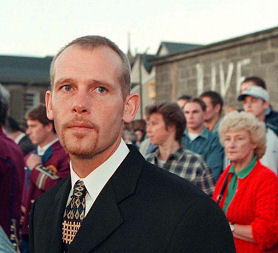No state collusion in Billy Wright’s murder
The inquiry into the murder of loyalist Billy Wright in Northern Ireland’s Maze prison finds there was no state collusion in his death, but “serious failings” by the authorities led to his killing.

Wright’s family had claimed that his murder by three Irish National Liberation Army (INLA) prisoners was part of a conspiracy involving the authorities – and said today there was “firm and final” proof of this.
But Northern Ireland Secretary Owen Paterson told the Commons: “There was no state collusion in the murder of Billy Wright.”
Wright’s father David said: “It looks like collusion, it sounds like collusion and in my mind amounts to firm and final proof of collusion by state agencies.”
The inquiry, set up by the previous government, found that there were a number of failings by the prison authorities before his death in 1997, but these were “the result of negligence, rather than intentional acts”. It concluded that it was wrong to house Wright in the same block as INLA inmates.
Mr Paterson apologised for the murder. “His murder in a high security prison should never have happened. It was wrong and I am sincerely sorry that failings in the system facilitated his murder.”
But he said prison staff were working in difficullt circumstances, with responsibility for 500 “extremely dangerous terrorists” from loyalist and republican groups.
He added: “This inquiry has cost over £30m and lasted over five years. Our views on these matters are well documented. Let me reiterate to the House, as the Prime Minister has done, that there will be no more costly and open-ended public inquiries.
“The report is a clear account of the shortcomings in the management and running of the Maze at the time of Billy Wright’s death. But any allegations that the state colluded in this violent killing have now been examined and rejected.”
David Wright said the way the guns used to kill his son were smuggled into the Maze had not been properly addressed.
He added that the failure by the police to pass on information about threats against Billy “constituted dreadful acts of omission that facilitated his death”.
Wright, whose nickname was King Rat, was the leader of the loyalist splinter group, the Loyalist Volunteer Force (LVF) and was allegedly linked to up to 20 murders of Catholics.
At the time of the killing, he was in the back of a prison van waiting to be taken to meet his girlfriend when he was shot seven times.
Three INLA prisoners shot him dead after slipping through security. The fact he was killed in a high-security prison has led to claims that the authorities colluded with the INLA to have an opponent of the peace process taken out – allegations that have been denied by the INLA.
The Billy Wright story
He became a born again Christian and preacher, soon realising that his
paramilitary activities - supposedly on behalf of Northern Ireland's Protestants
- were at odds with the message of his faith.
Two of the three killers, Christopher “Crip” McWilliams and John Kennaway, had been transferred into the same H-block as Wright the previous May, just weeks after he was moved from Maghaberry prison to serve out an eight-year sentence.
McWilliams, Kennaway and John Glennon shot him after hearing his name announced over the prison public address system. They surrendered to prison staff and were later sentenced to life imprisonment, but released early under the terms of the 1998 peace deal.
Wright, who was 37 when he died, broke away from the Ulster Volunteer Force, in protest at its leadership’s call for a ceasefire, and set up the LVF.
The inquiry was set up in 2007 after investigations by retired Canadian judge Peter Corry into allegations of collusion by prison staff. He said at the time that “there was sufficient evidence of collusive acts by prison authorities to warrant the holding of such an inquiry”.
The report looked at the role of the security services, including the Royal Ulster Constabulary; the decision to keep Wright and other LVF members in the same H-block as the INLA; and security lapses which allowed the INLA to smuggle in two guns.